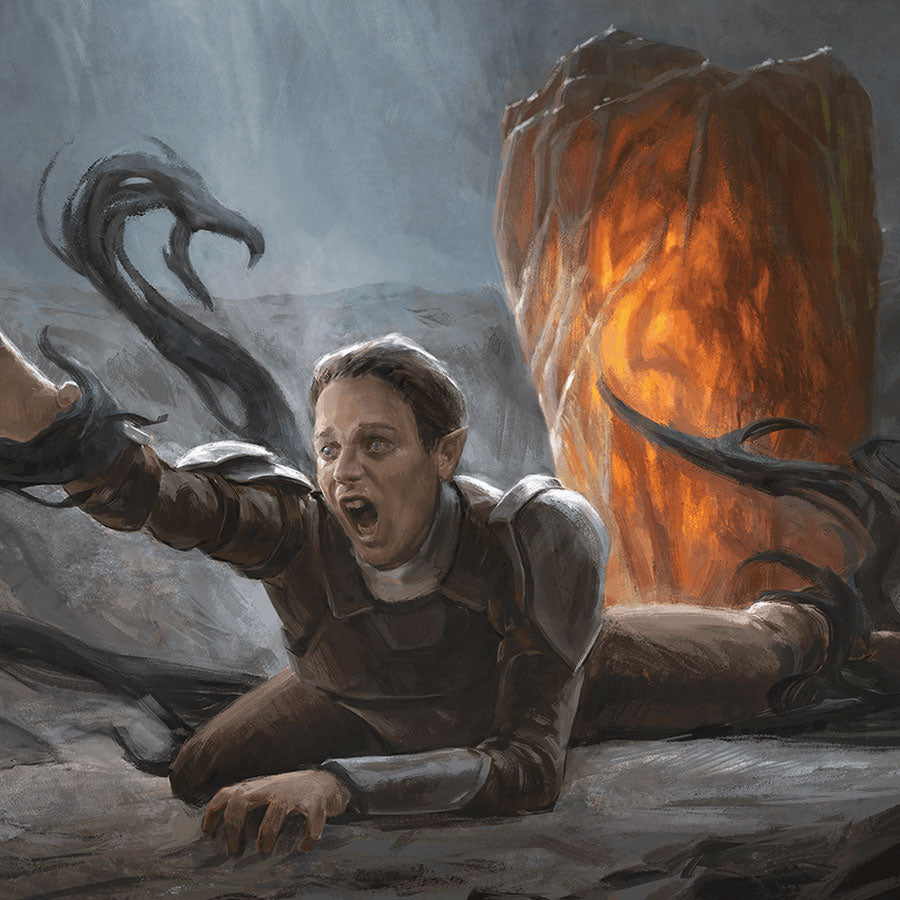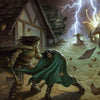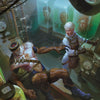How to Write a D&D Backstory | The Perfect Backstory Template!

A player once gave me a D&D character backstory that was a real piece of work.
First, it was devoid of all originality—I think their PC was modeled off some anime character or something—and it was full of TRAGIC OVERLOAD. You know, where excessive tragedy or trauma overshadows all other aspects of the character.
It was overly complicated with too many details, twists, and convoluted elements. It was inconsistent with the game world, and I had no idea how I could possibly integrate their backstory into the campaign. Oh, and their character was one of the dark-cloaked LONERS at the corner table in the tavern that doesn’t want to work with anyone else. Not that it mattered, because they had zero motivation to adventure, to travel, to do anything—besides brood on their dark past, I suppose.
However, HOWEVER, their character was the exemplar of perfection, possessing not only no flaws but also a level of power practically unheard of…even as a level one PC. And if that’s not enough, this backstory was dozens of pages long. They practically wrote me a novella.
And the worst part—the worst part of all of that, is that I wrote that backstory. I was that player.
So today, since I’ve learned a thing or two over the years, we’re going to deep dive into how you SHOULD write character backstories for TTRPGs, such as Dungeons & Dragons, Pathfinder, Dungeon Crawl Classics, and the like.
If you'd like, I have a free character backstory template that you’re welcome to use if you’re not sure where to start. And if you’re a game master, you might find it useful to give to your players—modified to suit your particular campaign—to help them develop their backstories.
By the way, are you a NEW GAME MASTER feeling a bit overwhelmed by everything involved with running a role-playing game? If so, the Secret Art of Game Mastery can help. Get over 100 years of GM experience distilled into practical, easy-to-read advice.
Watch or listen to this article by clicking the video below.
Defining a Character Backstory and Its Purpose
First, let’s talk about the basics of creating a character backstory, and to kick that off I think we should DEFINE a backstory.
You see, the backstory serves two principal purposes. First, it’s a resource for the player to use when roleplaying their character. If you know your character’s past, where they came from, their motivations and goals, etc., you’re going to be able to roleplay them that much better. However, the second purpose that I feel is often overlooked is that a character backstory should ALSO be a resource for the GAME MASTER to tie the character into the campaign. Also, remember that a backstory shouldn't be the end of the character's story, but rather the end of the BEGINNING of the story. After all, most likely the most interesting part of your characters’ story is just about to start with the launch of the campaign.
Thus, to that end, you should talk to the game master BEFORE making your backstory. You want to know such things like what they’re looking for in the character’s history. Ask your GM things like how long they want the backstory to be; how many details it should have; what KIND of details should it have?
Also—and this is SUPER important—make sure you ask your GM how much they INTEND to incorporate character backstories into the campaign. Not only do some GMs use backstories in the campaign more than others, but some campaigns lend themselves much less to the incorporation of backstories.
For instance, if the group is playing a module, it’s not unreasonable to expect to see less backstory stuff come up. That’s just often the nature of using prewritten adventure modules. However, even GMs who homebrew their adventures might not use backstories too much. Now, I personally think that is a mistake and they are probably missing out on a great opportunity, but that’s neither here nor now.
This is what I’m driving at. If the GM isn’t intending to incorporate backstories too much or at all, recognize that your backstory will primarily be a tool for YOU to use when roleplaying your character. So, you might consider not making it too long nor detailed—unless you want to, of course—and especially don’t try to shoehorn it into the campaign if the GM has already stated they won’t be incorporating backstories very much.
On the other hand, if the game master tells you they plan to base the entire campaign or large parts of it on character backstories, you should strive to give them exactly what they need to do that. And your GM should be prepared to tell you exactly what that is, but if they aren’t, then just ask and pester them until they do.
The Big Picture
Now, as you’re making your backstory, you want to make sure it fits into the game world and the plans the GM has for the campaign. It’s a best practice for a GM to tell players a little bit about the campaign—often this is done as a campaign pitch designed to get player buy-in and/or feedback—so you should know at least a little bit. You’ll want to know basic things like where the campaign is taking place; what the core themes of the campaign are; and what the intended TONE of the campaign is. These are all considerations that will help you mold your backstory to fit in.
Next, keep the backstory appropriate for the character’s level. This is one of the mistakes I made with my backstory once. I had a level one rogue’s backstory state him as being a master assassin who had risen to the top levels of his thieves’ guild. And of course that makes no sense. Level one rogues aren’t master assassins and they don’t lead thieves guilds. It would have been far more appropriate to have been an initiate in the thieves guild and now I was out in the world trying to hone my skills and earn my keep in the guild.
Okay, the next one here is MASSIVELY important. Please, please, please, for the love of all that is holy, GIVE YOUR CHARACTER A REASON TO ADVENTURE. I cannot tell you how many times I’ve heard stories of players who make characters who are like farmers or blacksmiths and they don’t want to leave the farm or the forge. I mean, that’s NOT a good backstory, UNLESS there is something that happens to force them to leave and go on adventures. But if they just want to stay there and not leave, that is an absolutely horrible thing to pull on your game master. You’re essentially undermining the campaign before it’s even begun. What do you expect your GM to do? To spend time every game session proding you to put down your rake and hoe? Like if you don’t want to play the game, just don’t play the game. If you don’t like the campaign premise, then find a different campaign to play in. You don’t have to make everyone else at the game table suffer.
As a corollary to that point, is my next one: your character should have a REASON to work with other and join a party of adventurers. In a social group game like D&D or Pathfinder where the premise of the entire game system is that of a united adventuring party, there is no room for lone wolves who hate working with others. Players who make characters like that—justifying it through their backstory—are not only undermining the campaign, but also the group dynamics. Furthermore, they are practically forcing the game master to run TWO GAMES instead of just one—the first game being the primary campaign, and the second being whatever the lone wolf character decides to do off on their own.
Now, you can kick and scream all you want justifying this sort of behavior and saying that players should have agency to create characters like this if they want, but this is a hard line in the sand for me. If I say I’m running a D&D game, I’m running a D&D game which means we’re going on adventures and there will be monsters. We’re not playing Farmville. And at my table, we run group games; there is no room for a player who refuses to adventure with the rest of the group.
Now, if that’s not your cup of tea, that’s fine. My games might not be for you. The great news is that playstyles differ greatly, and I’m sure there are lots of wonderful game masters out there running games that you’ll love. My point is that a player should RESPECT the type of game a GM says they’re going to run and show up ready to play THAT game. Otherwise, move on and find a GM running the type of game you’re looking for.
Okay, two final overview points, and then we’ll move on to what you should include in your backstory.
First, it's okay to have a "secretive" character backstory, but it should NOT be a secret to the game master. Remember when we said a backstory has two purpose, one to help you roleplay your character, and the other to help the GM. Well, if you don’t tell your GM all your backstory secrets, they can’t effectively do their part with the backstory.
Second, as a player, you should refer back to and use your backstory when playing the game to inform your roleplaying. And you should REMEMBER your backstory so that when backstory elements come up in the game you recognize them. There is nothing more agonizing for a GM than to spend time working in backstory elements only for players to not even recognize them. If leaves us wondering why we even bothered.
Character Backstory Specifics
Alright, with all the high-level basics out of the way, let’s take a look at some of the specifics of what you should include in your backstory. We’ll dive deeper on each, but to list them off they are: background elements, character motivations, and, game master hooks.
One of the first things to consider for your backstory is the BACKGROUND of your character. And this makes sense. In fact, if you had NO IDEA what a backstory even was, you’d probably assume it was creating the character’s background before they become an adventurer. And that’s exactly the high-level concept. You want to answer questions such as who your character’s parents were; were they raised in a wealthy family or poverty? Large city or rural area?
And then you want to consider the SIGNIFICANT EVENTS that shaped your character’s life. What was their occupation before they become an adventurer? What pushed the character to become an adventurer? This may be considered their defining moment. Was it a traumatic event or a major loss? And how did these events impact your character’s personality and worldview? How and why did your character choose (or fall into) their chosen class and skill set?
Your character’s background should ground them into the campaign setting and inform their personality and motivations.
Speaking of which, determining what your character’s motivations are is the next step, and a massively important one at that. Your character’s motivations will impact how you roleplay them and likely how your game master uses your backstory in the campaign. Consider things such as what your character wants; what your character fears; what are their likes and dislikes; does your character have some secret they don’t want anyone to learn about; are they hiding something shameful from their past?
And this leads us to the next logical step: determining what your character cares about. Are they seeking power so they can get revenge on the evil mage that burned down their village? Are they trying to redeem themselves from past mistakes? Do they simply want to help the common folk and do good in the world? Are they in it for the gold perhaps?
Something that can help both you and the game master here is determining a few significant NPCs from your character’s past that they care about and why. A good rule of thumb for significant, player-developed NPCs is to have between two and five, with the higher number for campaigns that will go into the higher levels. These NPCs can be friends, family, or even rivals and antagonists—any of these are GREAT for GMs looking to incorporate NPCs from your past into the campaign. Just remember, don't go overboard. The GM can only include so much and you're not the only player.
And this brings us to game master hooks. Here what you want to do is give your game master something specific to work with. Yes, there will probably already be stuff they can use from what you’ve already written about your character, but in this step we want to give them specific ammunition they can use to bring our backstory into the game.
Here are some potential hooks you might give them: an unsolved mystery; a secret that your character doesn’t want others to know; or a foil, rival, or enemy involved in your character’s past that hasn’t been resolved. By the way, for more information on using foils and rivals in your game, check out this video on the topic. However, for GM hooks, be careful not to fill in all the blanks. You don’t need to flesh out the specifics of the unsolved mystery, for instance; some basic information is all that’s needed. This then allows your game master to run with it and customize it so it fits into the campaign and adventures.
Along this line of thinking, remember that whatever you create for your characters’ backstory is just what’s currently known; your game master may add more once it passes into their hands and they begin incorporating it into the campaign. A good game master will practice the “yes and” technique of adding to your backstory, of course, and they should also be careful not to invalidate your past or take your character’s backstory in directions that are not in the spirit of the backstory or the game. However, we’ll dive into that sort of thing more in a future article I have planned specifically for game masters that discusses HOW to use character backstories in your campaign.
Okay, now let’s talk about LENGTH. How long should your backstory be? In my opinion, the backstory should be short enough to be digested and referenced. One or two pages is the sweet spot for me. Once we get into the five page plus territory, it’s going to be hard for both player and GM to reference and find information in it when needed without re-reading everything.
I once had a player give me a backstory that was some 20 pages long, and I won’t lie, I don’t think I ever read it. I’m sure they loved writing it, and I hope it helped them to roleplay their character. However, as a game master I have a LOT of stuff to do to prep the game—on top of everything in my real life, of course—so extremely long backstories are frankly impediments for me. Now if you LOVE writing long backstories, this is my recommendation. Write your long backstory; dig into that baby. However, afterwards, write a one-page summary for your game master to use and reference. Shoot, you’ll probably find that summary useful, too.
What about format though? Should your backstory be written as a literal story, like you would write in 9th grade English? Should it be a bullet list of main points? I don’t think there is a right answer to this, but I’ll tell you my preference, what I do.
I have a backstory template that I literally give to my players to fill out. It’s about two pages long, and it’s essentially a list of questions for them to answer. I’ve found this does a few things: First, it gives the player guidance on where to even start because sometimes players just don’t know how to make a backstory or what to include. Second, it helps ensure the players are providing information about their character that helps them roleplay and helps me incorporate their backstory into the campaign. Finally, it ensures the length of the backstory is something manageable for both me and the players. Many times we will literally fill out the backstory template as a group at the game table, perhaps during session zero, as that guarantees it gets done.
Now, as I said before, the backstory template I use in my games is available for free if you’d like to use it or customize it for your campaigns. I will say though, that I recently updated it; so, if you’ve grabbed it before, you might want to go over and get the most recent version.
I have one final SUPER important point for you to remember: once you give your backstory to the GM and the campaign begins, it no longer belongs to you. It belongs to the Campaign. The GM can and likely will play with it, adapt it, and use it to propel the characters and campaign forward. Thus, if there is some aspect of your backstory that you don't want your GM to twist or poke at, TELL THEM!
100 Years of GM Experience at Your Fingertips!
Are you a NEW GAME MASTER feeling a bit overwhelmed by everything involved with running a role-playing game? Are you a VETERAN GAME MASTER looking for new tips and tricks to take your games to the next level? Look no further than the Secret Art of Game Mastery.
We at the DM Lair have distilled our CENTURY of accumulated GM experience into an easy-to-read guide of practical advice that you can immediately apply to your games! We've even included our own templates–the things that we use to prepare our ACTUAL games.
Get all three books to master your game:
- The Secret Art of Game Mastery. Contains over 100 years of GM advice distilled into an easy-to-read format. It introduces and explains the tools of the trade, scheduling, playstyle, post-game notes, getting player feedback, and more.
- The Secret Art of Preparation. Brings to your fingertips the actual templates and guides that the DM Lair team uses to prepare games, Lair Magazine, and more. Designed as a three-ring binder, it's intended for you to write directly into for your entire campaign!
- The Secret Art of Notetaking. Gives you the keys to tracking your campaign from session to session just like the DM Lair team. Designed as a three-ring binder, it's intended for you to write in and keep track of your whole campaign!
With so much knowledge and experience on its pages, The Secret Art of Game Mastery is guaranteed to become an indispensable tool for all game masters, new and veteran alike. And if that isn’t enough, the information applies to all game systems and all genres!
-
Posted in
Game Master How-To Articles







